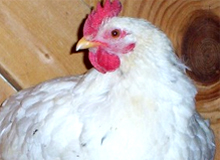EFSA: Welfare of broiler chickens and their breeding in spotlight

EFSA’s Panel on Animal Health and Welfare (AHAW) has adopted a scientific opinion on the influence of genetic selection on the welfare of broilers and another opinion on the influence of housing and management on the welfare of broiler breeders.
EFSA’s experts say that most welfare concerns are linked to fast growth rates, a result of genetic selection in chickens. They also identify concerns originating from the interaction of genetic traits and the chickens’ environment (for instance the housing and management of poultry farms). These opinions will help the European Commission in preparing a report which will be submitted to the European Parliament and to the Council.
Over the second half of the 20th century the growth rate of broilers increased 4 times mainly as a result of genetic selection. Whilst it is generally accepted that welfare problems in these chickens are caused by genetic selection aimed at increasing their productivity, genetic selection can also offer an opportunity to improve their welfare and robustness. Genetic selection of chickens now includes aspects related to welfare; however, improvements, or otherwise, in this area are difficult to quantify because robust data are not available. The experts on EFSA’s AHAW Panel emphasise the need to develop and monitor welfare indicators in broiler flocks to measure welfare changes. They also stress the lack of harmonised quantitative data in Europe to fully evaluate the impact of genetic selection, and the impact of the system of husbandry and management of broiler breeders on birds’ welfare. Experts call for systematic data collection and surveillance systems to be put in place.
The experts considered the peer-reviewed scientific literature and also analysed information gathered in consultation with stakeholders, such as the poultry industry, breeding companies, research groups, and non-governmental organisations[3].
Scientific opinion on the influence of genetic selection on the welfare of broilers
For broilers, the major welfare concerns identified and associated with genetic selection were skeletal disorders leading to problems such as lameness, contact dermatitis, irregular body shape and sudden death syndrome. These concerns are mostly linked to fast growth rates and lead to poor welfare. Experts note differences between countries, regions, and different farming systems.
The experts highlight that the welfare of broilers could be improved, particularly if birds are genetically selected to withstand the environment they live in; for example, birds that grow more slowly should be selected for hot climates as fast growing broilers are susceptible to heat stress. Moreover, in the genetic selection of chickens, high priority should be given to decreasing the number of lame birds and reducing contact dermatitis. These are important welfare problems which involve genetic predisposition and environmental conditions[4].
Scientific opinion on the influence of housing and management on the welfare of broiler breeders
Due to selection for fast growth and high muscle yields, breeders have a very high food intake. Feed restrictions are therefore necessary to limit growth rate to maintain good health. Experts recommend that the competition for food (which can be observed among chickens when feed is not provided) should be minimised thereby reducing related injuries. Experts also recommend that birds requiring fewer feed restrictions should be selected as future breeders.
For breeders, experts identify five major risks factors having an impact on welfare related to management or genetic selection. Management factors are barren environment, density of animals, feed restriction and limited sources of light, and the genetic factor is fast growth rate. There are also welfare concerns resulting from the interaction between genetics and the environment.
The opinion states that providing stimuli such as perches and raised nest boxes are beneficial for the welfare of broilers kept for breeding.
They also recommend that management practices aimed at reducing injuries – such as removing part of the toe or comb – should either not be carried out or, if necessary, only by trained personnel using the least painful method.
- Scientific Opinion on the influence of genetic parameters on the welfare and the resistance to stress of commercial broilers
- Scientific Opinion on welfare aspects of the management and housing of the grand-parent and parent stocks raised and kept for breeding purposes
- Outcome of the Stakeholders and Public consultation on Health and Welfare aspects of genetic selection in broilers
- Further consultation on animal welfare implications of genetic selection in chickens
- Technical meeting on animal welfare aspects of genetic selection in broilers and broiler breeders
Source: EFSA












